Ceramic items are elegant, durable, and often hold sentimental value, but accidents happen. Whether it’s a shattered mug, a broken vase, or a cracked plate, fixing ceramics requires the right adhesive to restore both strength and appearance. Using the wrong glue can lead to weak bonds, visible seams, or even further damage.
The best glue to fix ceramics combines strong adhesion, durability, and ease of use, ensuring your repaired items are both functional and visually appealing. Factors such as drying time, water resistance, heat tolerance, and gap-filling ability are essential to consider. In this guide, we’ll walk you through the top types of glues suitable for ceramic repair and highlight what to look for when choosing the ideal adhesive for your project.
🛠️ Buying Guide: How to Choose the Best Glue to Fix Ceramics
When selecting a ceramic adhesive, consider the following factors:
1. Type of Adhesive
- Epoxy Glue: Two-part glues that form extremely strong bonds, ideal for heavy or structural repairs.
- Super Glue (Cyanoacrylate): Fast-drying glue suitable for small cracks or decorative items. Bonds almost instantly.
- Polyurethane Glue: Slightly expands as it cures, perfect for filling gaps and uneven surfaces.
- Ceramic-Specific Adhesive: Designed for porcelain and ceramics, often heat- and water-resistant.
- Artistic Repair Kits (Kintsugi): Glues infused with gold or silver for decorative restoration.
2. Bond Strength
- Choose adhesives rated for ceramic or porcelain.
- Epoxies generally offer the strongest bonds, while super glues are ideal for lightweight repairs.
3. Drying & Curing Time
- Fast-drying glues are convenient for quick fixes but require careful application.
- Epoxies or specialized ceramic glues may take longer but provide stronger, longer-lasting bonds.
4. Waterproof & Heat Resistance
- For kitchenware, bathroom items, or outdoor ceramics, ensure the glue is waterproof and heat-resistant.
- Food-safe glues are essential if the item will contact food or drink.
5. Gap-Filling Capability
- Some adhesives shrink as they cure, leaving weak spots.
- Epoxy or polyurethane adhesives can fill gaps and work well on chipped or uneven breaks.
6. Ease of Application
- Check for precise applicators for intricate repairs.
- Consider whether excess glue is easy to clean before it hardens.
7. Appearance After Drying
- Clear-drying glues maintain the aesthetic of the ceramic piece.
- Some adhesives can be sanded or painted to blend with the ceramic surface.
Next, we can review the top 6 glues to fix ceramics available on Amazon, including detailed descriptions, pros, cons, and recommendations for each product.
Do you want me to go ahead and write those 6 product reviews?
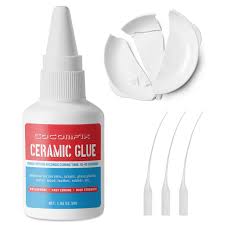
1. Cocomfix Ceramic Super Glue (30g)
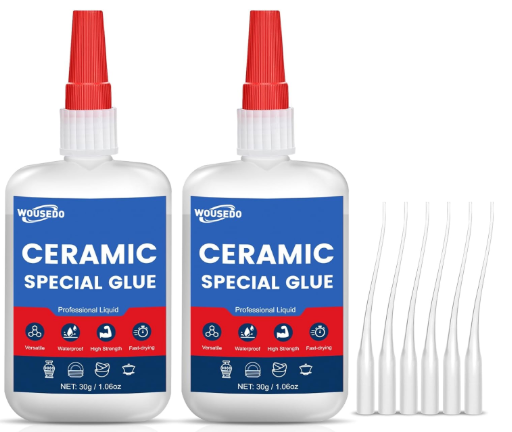
- Description: A fast-drying, waterproof adhesive designed for pottery, porcelain, and ceramic repairs.
- Key Features:
- Quick-drying formula
- Water-resistant
- Suitable for porous surfaces
- 30g capacity
- Pros:
- Ideal for repairing broken ceramics and pottery
- High adhesion strength
- Anti-clogging design
- Cons:
- May not be suitable for non-porous surfaces
- Recommendation: Best for general ceramic repairs, especially on porous materials.
2. ATLASBOND Ceramic Glue (50g)
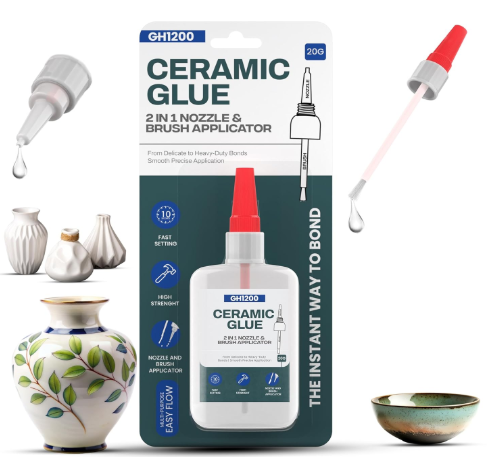
- Description: A super clear, fast-drying glue for porcelain, pottery, and china repair.
- Key Features:
- Food-safe
- Dries clear
- Heat-resistant
- Strong bonding
- Pros:
- Safe for items that come into contact with food
- Invisible repairs due to clear drying
- Suitable for high-temperature applications
- Cons:
- Requires precise application for best results
- Recommendation: Ideal for repairing kitchenware and decorative ceramics.
3. Ankita Ceramic Super Glue (30g)
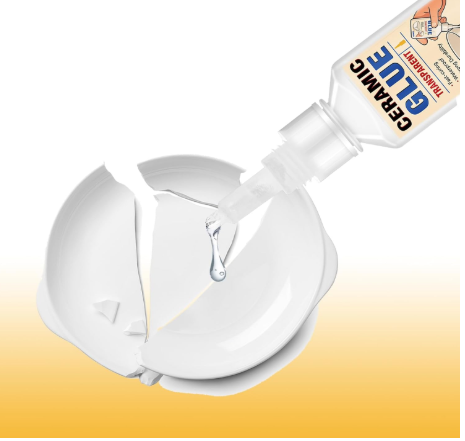
- Description: A waterproof and multi-surface adhesive for all bonding needs with high-temperature resistance.
- Key Features:
- Waterproof
- High-temperature resistant
- Multi-surface bonding
- 30g capacity
- Pros:
- Versatile for various materials
- Durable and long-lasting bond
- Quick-setting formula
- Cons:
- May require surface preparation for optimal adhesion
- Recommendation: Suitable for both indoor and outdoor ceramic repairs.
4. GleamGlee Ceramic Super Glue (35g)
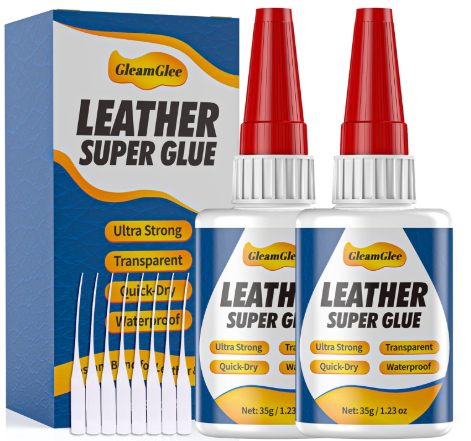
- Description: An ultra-strong, waterproof, high-temperature resistant, food-grade adhesive for mugs, dishes, tiles, and crafts.
- Key Features:
- Ultra-strong bonding
- Waterproof and heat-resistant
- Food-grade
- Quick-drying
- Pros:
- Safe for items that contact food
- Suitable for high-temperature environments
- Fast-setting for quick repairs
- Cons:
- Requires careful application to avoid excess glue
- Recommendation: Best for repairing kitchenware and items exposed to heat.
5. WoldoClean Ceramic Super Glue (25g)
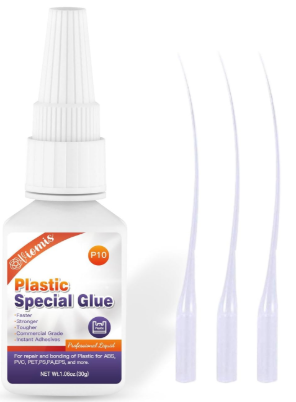
- Description: A fast-drying, heat-resistant, waterproof adhesive with high bonding strength for porcelain and pottery repair.
- Key Features:
- Fast-drying
- Heat-resistant
- Waterproof
- High bonding strength
- Pros:
- Quick and easy application
- Durable bond suitable for everyday use
- Ideal for repairing various ceramic items
- Cons:
- May not be suitable for decorative items requiring invisible repairs
- Recommendation: Ideal for functional ceramic repairs.
6. WoldoClean Ceramic Super Glue (25g)
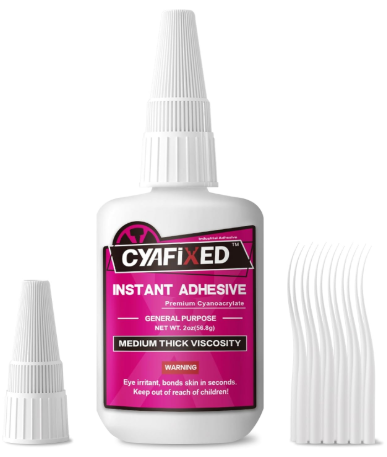
- Description: An ultra-fast drying glue for ceramic, porcelain, and stoneware repairs, ensuring durable and transparent bonds.
- Key Features:
- Ultra-fast drying
- Transparent finish
- Water-resistant
- Heat-resistant
- Pros:
- Quick-setting for immediate use
- Invisible repairs due to clear drying
- Suitable for various ceramic materials
- Cons:
- Requires precise application to avoid excess glue
- Recommendation: Best for quick and discreet ceramic repairs.
Comparison Table:
| Product Name | Capacity | Food-Safe | Heat-Resistant | Waterproof | Drying Time | Best For |
|---|---|---|---|---|---|---|
| Cocomfix Ceramic Super Glue | 30g | No | Yes | Yes | Fast | General ceramic repairs |
| ATLASBOND Ceramic Glue | 50g | Yes | Yes | Yes | Fast | Kitchenware and decorative items |
| Ankita Ceramic Super Glue | 30g | No | Yes | Yes | Fast | Indoor and outdoor repairs |
| GleamGlee Ceramic Super Glue | 35g | Yes | Yes | Yes | Fast | Kitchenware and heat-exposed items |
| Viomis Ceramic Super Glue | 30g | No | Yes | Yes | Fast | Functional ceramic repairs |
| WoldoClean Ceramic Super Glue | 25g | No | Yes | Yes | Very Fast | Quick and discreet repairs |
How to Use Ceramic Glue:
- Prepare the Surface: Clean both ceramic surfaces to be bonded with rubbing alcohol or soapy water. Ensure they are dry before proceeding.
- Apply the Glue: Apply a small amount of glue to one of the surfaces. Be cautious not to use excess glue to prevent overflow.
- Join the Pieces: Press the two surfaces together firmly, holding them in place for the time specified by the glue manufacturer.
- Allow to Cure: Let the bond cure for the recommended time before handling the item.
Safety Guide:
- Ventilation: Use glue in a well-ventilated area to avoid inhaling fumes.
- Protective Gear: Wear gloves to prevent skin contact and safety glasses to protect your eyes.
- Storage: Keep glue out of reach of children and pets. Store in a cool, dry place.
- Handling: Avoid ingesting glue. If contact occurs, follow the manufacturer’s safety instructions.
FAQs:
- Q: Can I use these glues for outdoor ceramic items? A: Yes, many of these glues are heat and water-resistant, making them suitable for outdoor use.
- Q: Are these glues safe for food-contact ceramics? A: Some glues, like ATLASBOND and GleamGlee, are food-safe. Always check the product specifications.
- Q: How long does it take for the glue to set? A: Drying times vary; most set within 10-45 seconds, but full curing may take up to 24 hours.
- Q: Can I use these glues for decorative ceramic repairs? A: Yes, especially if the glue dries clear and is suitable for delicate applications.
Conclusion:
Choosing the right glue for ceramic repairs depends on the specific requirements of your project. For general repairs, Cocomfix and WoldoClean offer fast-drying, strong bonds. For kitchenware and food-contact items, ATLASBOND and GleamGlee provide food-safe options. Ankita and Viomis are versatile choices for both indoor and outdoor repairs. Always consider the specific needs of your ceramic item and select the adhesive that best matches those requirements.
Here’s a concise comparison table for the six ceramic glues reviewed:
| Product Name | Capacity | Food-Safe | Heat-Resistant | Waterproof | Drying Time | Best Use Case |
|---|---|---|---|---|---|---|
| Cocomfix Ceramic Super Glue | 30g | No | Yes | Yes | Fast | General ceramic repairs |
| ATLASBOND Ceramic Glue | 50g | Yes | Yes | Yes | Fast | Kitchenware & decorative items |
| Ankita Ceramic Super Glue | 30g | No | Yes | Yes | Fast | Indoor & outdoor repairs |
| GleamGlee Ceramic Super Glue | 35g | Yes | Yes | Yes | Fast | Heat-exposed & food-contact items |
| Viomis Ceramic Super Glue | 30g | No | Yes | Yes | Fast | Functional ceramic repairs |
| WoldoClean Ceramic Super Glue | 25g | No | Yes | Yes | Very Fast | Quick and discreet repairs |
This table highlights capacity, food safety, heat/water resistance, drying time, and ideal use to help you quickly choose the most suitable ceramic glue.
How to Use Ceramic Glue
- Prepare the Surface
- Clean both broken ceramic pieces thoroughly.
- Remove dust, grease, or old adhesive with rubbing alcohol or warm soapy water.
- Dry completely before applying glue.
- Dry Fit the Pieces
- Fit the pieces together without glue to ensure proper alignment.
- This prevents mistakes once adhesive is applied.
- Apply the Glue
- For super glue or liquid adhesives, apply a thin layer on one surface.
- For epoxy or two-part adhesives, mix components as directed and apply immediately.
- For gap-filling adhesives, slightly overfill to accommodate shrinkage as it cures.
- Join the Pieces
- Press the pieces together firmly.
- Hold in place for the recommended time (seconds for super glue, minutes for epoxy).
- Clamp or Support if Needed
- Use clamps, rubber bands, or tape for larger or heavier items.
- Ensure pieces do not shift while curing.
- Allow to Cure Fully
- Follow manufacturer’s instructions for curing time.
- Avoid moving or stressing the item until fully set.
- Clean Excess Glue
- Wipe away extra glue immediately with a damp cloth or cotton swab.
- For hardened glue, gently scrape or sand after curing.
Safety Guide for Using Ceramic Glue
- Work in a Well-Ventilated Area
- Adhesives can emit fumes. Open windows or use a fan to reduce inhalation risk.
- Wear Protective Gear
- Gloves protect skin; safety glasses prevent accidental splashes in eyes.
- Avoid Skin Contact
- Super glue bonds instantly; soak stuck glue in warm soapy water before peeling it off.
- Keep Away from Children and Pets
- Small shards and glue can be hazardous.
- Avoid Food Contamination
- Use only food-safe glues for items that contact food or drink.
- Proper Storage
- Seal containers tightly after use.
- Store in a cool, dry place away from heat and sunlight.
- Follow Manufacturer Instructions
- Observe drying, curing, and application guidelines.
- Incorrect use can lead to weak bonds or damage.
Frequently Asked Questions (FAQs)
1. General Questions
Q1: What is the strongest glue to fix ceramics?
A: Epoxy adhesives, such as J-B Weld ClearWeld or similar two-part epoxies, provide the strongest and most durable bonds, suitable for heavy or structural ceramic repairs.
Q2: Can I use super glue for ceramic repairs?
A: Yes, super glue is effective for small cracks or decorative items. However, it may not fill gaps well and is less durable for heavy or functional items.
Q3: Can I repair food-contact items like mugs or plates?
A: Only with food-safe adhesives such as ATLASBOND Ceramic Glue or GleamGlee Ceramic Super Glue. Regular super glue is not safe for food contact.
2. Application Questions
Q4: How long should I wait before using a glued ceramic item?
A: Drying and curing times vary:
- Super glue: sets in seconds, fully cures in 24 hours.
- Epoxy: initial set in 5–10 minutes, full cure in 24 hours.
- Food-safe adhesives: follow the manufacturer’s instructions.
Q5: Can I glue multiple broken pieces together?
A: Yes. Start by bonding the largest pieces first, then add smaller fragments, ensuring proper alignment each time.
Q6: Is it safe to use glued ceramics in microwaves or dishwashers?
A: Only if the adhesive is specifically labeled as microwave- and dishwasher-safe. Most standard glues are not.
3. Safety Questions
Q7: Are ceramic glues toxic?
A: Some adhesives, like regular super glue or epoxy, emit fumes and are not safe for ingestion. Food-safe glues are specially formulated to avoid toxicity. Always read the label.
Q8: How do I remove excess glue from ceramics?
A: Wipe immediately with a damp cloth or cotton swab before it hardens. For cured glue, carefully scrape or sand it off.
Q9: Can ceramic glue bond other materials?
A: Many glues work on multiple surfaces such as metal, glass, wood, and plastic. Check the product label for compatibility.
Q10: How should I store leftover glue?
A: Seal containers tightly, store in a cool, dry place, away from children, pets, and direct sunlight.
Conclusion
Repairing broken ceramics doesn’t have to mean discarding valuable or sentimental items. With the right glue, you can restore both functionality and appearance.
- Super glues like Cocomfix and Viomis are ideal for quick, small repairs.
- Epoxies provide strong, durable bonds for heavy or structural repairs.
- Food-safe adhesives like ATLASBOND and GleamGlee ensure safety for kitchenware and food-contact items.
- Artistic repair kits or clear-drying glues allow for invisible or decorative repairs, enhancing both utility and aesthetics.
When choosing the best glue to fix ceramics, consider bond strength, drying time, heat and water resistance, food safety, and gap-filling capability. Following proper usage and safety guidelines ensures your repaired ceramics are durable, safe, and visually appealing, keeping your cherished items in use for years to come.